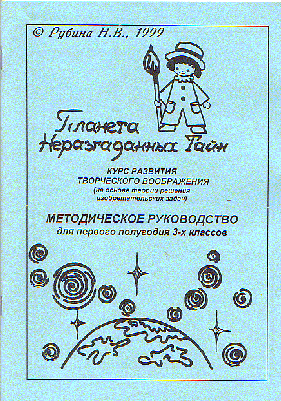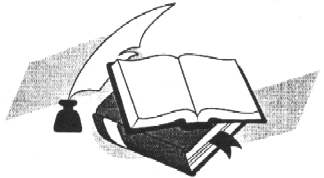Course of Creative Imagination Development (CID) Based on TRIZ, 3rd Grade, 1st Semester,
Methodical Guide-Book
List of posting in this Home Page:
| Dec. 17, 2001 | 3rd Grade/1st Semester "Planet of Unsolved Misteries" | Whole volume | Guide-Book | Workbook |
Editor's Note:
Please refer to the Editor's Preface (by T. Nakagawa) and the Author's
Introduction (by N. V. Rubina) on the top page of this Course textbook
series.
| Top of this page | Contents | Front Cover | Preface | Symbol marks | Weekly Topic Planning | CID Course Top Page |
Contents
of the CID Course, 3rd Grade, 1st Semester Course
Top Page:
| Book Title;
Grade/Semester |
Contents | Guide-
Book |
Work-
book |
Posted
date |
| "Planet
of Unsolved Misteries"
3rd Grade,
|
Preface and Weekly Topic Planning | Dec. 17,
2001 |
||
| Introduction | Dec. 17,
2001 |
|||
| 1. Method
of Solving Problems
(Contradictions, Ideality, and Resources) |
Dec. 17,
2001 |
|||
| 2. Methods of Solving Contradictions | Dec. 17,
2001 |
|||
| 3. Scheme of Solving Problems | Dec. 17,
2001 |
|||
| 4. Card Index
(Problem Synthesis) |
Dec. 17,
2001 |
|||
| Supplements 1 & 2 | --- | Dec. 17,
2001 |
(C) N.V.Rubina,
I. Dolina, T. Nakagawa, 2001
Planet of Unsolved Misteries
Course
of Creative Imagination Development (CID)
(Based on Theory of Inventive Problem Solving
(TRIZ))
METHODICAL GUIDE-BOOK
Third Grade, First Semester
Natalia V. Rubina
 |
 |

Planet of Unsolved Misteries
Course
of Creative Imagination Development (CID)
(Based on Theory of Inventive Problem Solving
(TRIZ))
METHODICAL GUIDE-BOOK
Third Grade, First
Semester

Natalia V. Rubina
Petrozavodsk 1999
English Translation by Irina Dolina, June 3, 2001
Technical Editing by Toru Nakagawa, December 8, 2001
The program of the CID course was elaborated and defined in Petrozavodsk in 1996. Six workbooks with special methodological recommendations (for each semester) were worked out. The program and all the methodological material were probated on the basis of the "TRIZ Laboratory" at the Petrozavodsk School #17.
This pamphlet introduces
the methodological instructions for the first semester of the CID third
grade ("Planet of Unsolved Misteries").
"Planet of Unsolved Misteries". Creative Imagination Development Course for the elementary school (The first semester of the third grade). Methodological instructions.
Reprints and distribution only by author's permission.
 |
(Instead of Preface) |
“What is it?", “What is it for?",
“Why is it like this?”- this is an unlimited row of children’s questions…
Probably, one of these questions is going to deprive of rest, to make search
for a long time, to become a guiding star for growing in your presence
a young genius?
One of the main aims of the CID course is
to show the children that the world is full of riddles and mysteries, and
that they can solve them by themselves. For these two years the kids
have mastered such strong instruments of thinking as a system operator,
the methods of making images, some rules and methods of solving problems,
and so on. In the third year the attention will be mostly focused
on the elements of the kid’s research work. The aim of the course
“Planet of Unsolved Mysteries” is to see unusual things, to put questions
correctly, to master the methods of searching solutions for the creative
problems. And here, the most important thing is to take into consideration
the children’s interests, their life experience, to arrange their work
in such a way that every lesson could be a small discovery for the children.
By the third grade the children have mastered
skill of the group and community work. It is known that the best
way of learning anything is to try to teach it to somebody else.
The work of most topics during the first semester of third grade (excluding
the topics of reviewing) is a micro-research on revealing mechanisms of
creative problem solving (i.e., “Methods of solving contradictions” and
“Method of problem solving”), on synthesis of creative problems (“Index
Card”), on applying of the acquired knowledge to independent research.
The children of this age group have various interests. Group them
according to their inclinations and abilities, interests in this or that
field of knowledge.
One of the discoveries that the children can
do by themselves is that rules and methods studied at the CID course
may be used in any field of human activities. Because any activity
is connected with the transformation of the systems surrounding a person.
TRIZ reveals laws with which systems are regulated. Using the TRIZ
methods in non-technical spheres, it is important to take into consideration
the properties, characteristic to the given systems, peculiarities of their
development, resources and so on.
So, the riddles and mysteries of Planet of Unsolved
Mysteries, that exist on the Earth and in the World of the children’s Fantasy,
are waiting for us.
The author expresses her gratidute to I. N. Murashkowska,
A. A. Nesterenko, M. S. Gafitulin, M. S. Rubin, whose works helped very
much in creating the CID course. And of course, the assistance of
the first to third grade students of School 17, Petrozavodsk is invaluable.
Thank you, my little magicians.
Your comments and suggestions please
send to: 185014, Petrozavodsk, mail box 8, OO “TRIZ – Karelia”,
For better
perception the following symbols are used in the methodical guide-book:
 |
- problems. For the first grade simple problems demanding answers "yes-no" are used. The major notions of the methods of solving problems are studied in the second and third grades. That is why the most suitable form for solving creative problems is a game "yes-no". The rules of the game are not difficult. After the problem is introduced the kids start to look for the solution by asking questions to which the teacher replies "yes" or "no". The aim of the game is to find a solution by asking as many questions as possible. |
 |
- activities. During these activities it is important that the kids understand how this or that notion may be used for solving the problems, for obtaining new ideas, etc. |
 |
- psychotechnical games. This is a specific part of the lesson. Kids may relax a little and turn to their inner world, the world of a child's fantasy. It goes without saying how important is the atmosphere of trust, friendliness in your small community. |
 |
- speech developing activities. We all know very well how easy to speak with a person who can ask interesting questions. CID classes are structured in a form of a dialogue, therefore actually any task is an exercise on speech developing. Nevertheless, devising their own riddles, proverbs, tales, the kid learns not only to say "full sentences", but develops a need to formulate his idea in such a way that he would be understood and his wits and humor be assessed. Describing various systems, solving unusual problems, the kids enrich their vocabulary all the time. |
 |
- designing a creative product. Don't be confused by an unusual term. "Creative product" is something finished, designed by the kids with the help of methods they study (a riddle, a proverb, a tale, a model of a toy, articles of natural materials and others). |
 |
- tasks-pictures. At the CID classes there are many activities like that because a new creative idea is often embodied in images, especially it refers to the kids with a strong visual representative system. Most of these tasks are unique stuff for a psychologist, for attentive parents, because in this pictures the inner world of a child is reflected as if in a mirror. |
Weekly Topic Planning
(3rd Grade, 1st Semester)
| Date | Topic | No. of hours | |
| September | 1st week | "Scale of Fantasy -- 2" | 1 hour |
| 2nd week
3rd week |
Topic 1. Method of Solving Problems
(Reviewing)
(Contradictions, Ideality, and Resources) |
2 hours | |
|
October |
4th week
1st week 2nd week 3rd week |
Topic 2. Methods of Solving Contradictions | 4 hours |
|
November |
4th week
1st week 2nd week |
Topic 3. Scheme of Solving Problems | 3 hours |
|
December |
3rd week
1st week |
Topic 4. Card Index
(Problem Synthesis) |
2 hours |
| 2nd week
3rd week |
DKR.
What to check:
types of resources; methods of solving contradictions
according to the scheme; |
2 hours |
|
[Translation Note (T.Nakagawa,
Dec. 8, 2001): This table of Weekly Topic Planning was modified slightly
to better match with the body of the text.]
| Top of this page | Contents | Front Cover | Preface | Symbol marks | Weekly Topic Planning | CID Course Top Page |
| Home Page | New Information | Introduction to TRIZ | TRIZ References | TRIZ Links |
| TRIZ News & Activities | TRIZ Software Tools | TRIZ Papers and Tech Reports | TRIZ Forum |
Last updated on Dec. 17, 2001. Access point: Editor: nakagawa@utc.osaka-gu.ac.jp